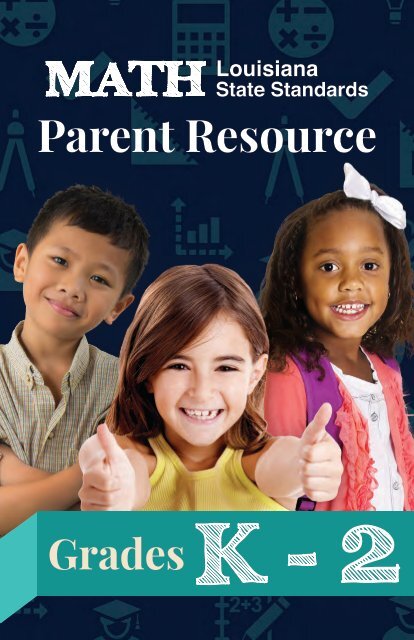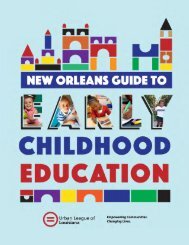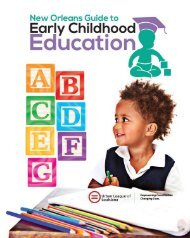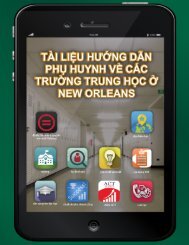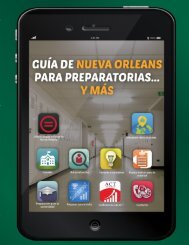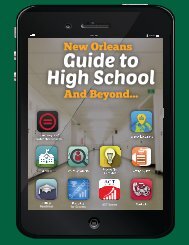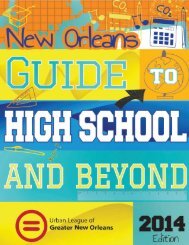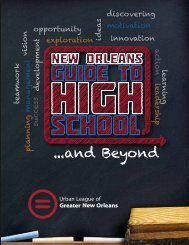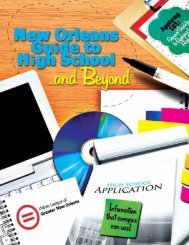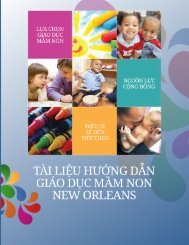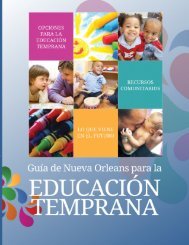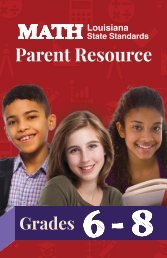youblisher.com-1259705-LA_Math_State_Standards_Parent_Resource_Grades_K_2
You also want an ePaper? Increase the reach of your titles
YUMPU automatically turns print PDFs into web optimized ePapers that Google loves.
Louisiana<br />
<strong>Parent</strong> <strong>Resource</strong><br />
<strong>Grades</strong>
Where U.S. Students Rank Globally<br />
The United <strong>State</strong>s Ranks:<br />
• 17 th In Reading Literacy<br />
• 21 st In Science<br />
• 26 th In <strong>Math</strong><br />
U.S. Chamber of Commerce Foundation 2014<br />
17 TH 21 ST 26 TH<br />
IN READING<br />
LITERACY<br />
IN SCIENCE<br />
IN MATH<br />
Based on 2013 International PISA results
Louisiana<br />
<strong>Parent</strong> <strong>Resource</strong><br />
<strong>Grades</strong> K – 2<br />
www.cdl.org<br />
Special thanks to the following partners:
| # |<br />
Center for Development and Learning
Introduction<br />
This guide provides an overview of what your child will learn by the end<br />
of kindergarten, 1st, and 2nd grade in <strong>Math</strong>. It focuses on key skills<br />
that will build a strong basis for success in college, the workplace,<br />
and everyday life. These K-12 standards were informed by Louisiana<br />
teachers, university professors, and other education experts. If your son<br />
or daughter is meeting the expectations outlined in these standards, he or<br />
she will be well prepared for the next grade.<br />
Why are high academic standards important?<br />
All parents want their children to be able to pursue their dreams –<br />
whatever they may be. A great education starts with high standards. A<br />
high level of academic rigor in our academic standards is necessary to<br />
ensure that students are learning up-to-date content that is important for<br />
their futures. Understanding what those standards are will help parents to<br />
ensure their children are receiving the best education possible.<br />
Of course, high standards are not the only things needed for children’s<br />
success, but they provide an important<br />
first step — a clear, consistent roadmap<br />
for learning. They also help your child<br />
develop real-world critical thinking skills<br />
needed for college and the workforce.<br />
How can I help my child?<br />
You should use this guide in two main<br />
ways: (1) as a tool to help students at<br />
home, and (2) as a resource to help<br />
build a relationship with teachers.<br />
This Guide Includes:<br />
• An overview of some<br />
of the key things your<br />
child should be learning<br />
in <strong>Math</strong> from kindergarten<br />
through 2nd grade<br />
• Ideas to help your child<br />
learn at home<br />
Talk to teachers regularly about how your<br />
son or daughter is doing so that you can<br />
work together to address any issues.<br />
<strong>Parent</strong>s are children’s first teachers.<br />
At home, you can play a big part in<br />
setting high expectations and supporting<br />
students in meeting them.<br />
• Topics of discussion for<br />
talking to your child’s<br />
teacher about his or her<br />
academic progress<br />
<strong>Math</strong> <strong>Parent</strong> <strong>Resource</strong> Guide K–2 | 3 |
About the CDL<br />
Founded in 1992, the Center for Development<br />
and Learning (CDL) is a results-driven Louisianabased<br />
501(c)(3) nonprofit organization. CDL’s<br />
programs and services fall into three major<br />
areas: (1) evidence-based professional learning<br />
for educators; (2) direct services to students; and<br />
(3) public engagement of stakeholders at all<br />
levels. We aim to increase student learning.<br />
CDL specializes in providing educators with<br />
professional learning that is specific and relevant<br />
to the needs of teachers and their students. We<br />
have particular expertise in effective leadership<br />
practices, evidence-based teaching strategies<br />
and tactics, early childhood best practices,<br />
literacy, and learning differences.<br />
With an on-the-ground, in-the-trenches approach,<br />
we tackle real-time issues such as ways to<br />
remediate struggling readers and writers,<br />
differentiating instruction, structuring collaborative<br />
classroom environments, building leadership<br />
capacity, and developing and sustaining<br />
collective capacity.<br />
© 2015 The Center for Development and Learning<br />
Editor: Keisha Dubuclet<br />
Graphic Designer: Lauren Richardson<br />
| 4 |<br />
Center for Development and Learning
Table of Contents<br />
Common Questions about Louisiana <strong>State</strong> <strong>Standards</strong> . . . . . . . . . . . . . 6<br />
Overview of <strong>Math</strong> <strong>Standards</strong> . . . . . . . . . . . . . . . . . . . . . . . . . . . . . . . 10<br />
<strong>Standards</strong> for <strong>Math</strong>ematical Practice . . . . . . . . . . . . . . . . . . . . . . . . . . 12<br />
<strong>Standards</strong> for <strong>Math</strong>ematical Content . . . . . . . . . . . . . . . . . . . . . . . . . . 17<br />
Kindergarten . . . . . . . . . . . . . . . . . . . . . . . . . . . . . . . . . . . 18<br />
First Grade . . . . . . . . . . . . . . . . . . . . . . . . . . . . . . . . . . . . . . 20<br />
Second Grade . . . . . . . . . . . . . . . . . . . . . . . . . . . . . . . . . . . . . 22<br />
Problem Solving in <strong>Math</strong> . . . . . . . . . . . . . . . . . . . . . . . . . . . . . . . . . . . . 25<br />
Kindergarten Examples . . . . . . . . . . . . . . . . . . . . . . . . . . . . . . . . 26<br />
First Grade Examples . . . . . . . . . . . . . . . . . . . . . . . . . . . . . . . . 30<br />
Second Grade Examples . . . . . . . . . . . . . . . . . . . . . . . . . . . . . . . . 34<br />
Special Education . . . . . . . . . . . . . . . . . . . . . . . . . . . . . . . . . . . . . 38<br />
How to Support your Child . . . . . . . . . . . . . . . . . . . . . . . . . . . . . . . . 40<br />
<strong>Math</strong> <strong>Parent</strong> <strong>Resource</strong> Guide K–2<br />
| 5 |
Common Questions about<br />
Louisiana <strong>State</strong> <strong>Standards</strong><br />
Q:<br />
A:<br />
What are the Louisiana <strong>State</strong> <strong>Standards</strong>?<br />
The Louisiana <strong>State</strong> <strong>Standards</strong> are learning goals that are<br />
designed to prepare our students for college and career<br />
success. <strong>Standards</strong> are not the same as a curriculum.<br />
Teachers can still decide how to get kids to the goal.<br />
Q:<br />
A:<br />
Why do we need rigorous standards?<br />
Louisiana is 3rd from the bottom in education <strong>com</strong>pared to the<br />
rest of the country. More rigorous standards will help give all<br />
Louisiana students a higher quality education so they can be<br />
successful in today’s economy.<br />
Q:<br />
A:<br />
Who developed the standards?<br />
Louisiana has always had standards. <strong>State</strong> law requires<br />
a review of academic standards every seven years. In<br />
2010, higher standards were adopted to ensure Louisiana<br />
students could <strong>com</strong>pete with those from other states. The<br />
standards are informed by Louisiana teachers, university<br />
professors, and independent education experts. <strong>Parent</strong>s,<br />
business leaders, and other stakeholders have the<br />
opportunity to provide feedback.<br />
| 6 |<br />
Center for Development and Learning
Q: How will high standards<br />
From Failing to<br />
affect student grades<br />
Fantastic: Winning the<br />
and school performance<br />
Education Game<br />
scores (SPS)?<br />
A:<br />
Some are concerned that<br />
school test scores and letter<br />
grades will drop. A drop in<br />
scores is expected at first<br />
because previous standards<br />
were not accurate indicators of<br />
college and career-readiness.<br />
<strong>State</strong> changes to school and<br />
teacher evaluations have been<br />
made that will give students<br />
and schools time to adjust.<br />
In football, the<br />
goal is to get<br />
a touchdown;<br />
it’s up to the<br />
coach to<br />
choose plays<br />
that will get<br />
the ball in the<br />
end zone.<br />
<strong>Standards</strong> set the goal; it’s up to<br />
the teacher to choose plays to<br />
help kids win.<br />
Q:<br />
A:<br />
How will higher standards affect me as a parent?<br />
As a parent, you may notice your child’s classwork and<br />
homework be<strong>com</strong>ing harder. You may also see a slight drop<br />
in grades. While it may be un<strong>com</strong>fortable and scary, this is<br />
normal because schoolwork and tests are more challenging.<br />
Keep in mind that now your kids are getting the high quality<br />
education they deserve but weren’t getting before.<br />
Q:<br />
A:<br />
How will higher standards affect students?<br />
Having high standards will require students to learn and apply<br />
more demanding concepts and procedures, resulting in deeper<br />
levels of understanding. Rather than simply memorizing,<br />
students will critically think through information and apply what<br />
they learn to solve real-world problems and situations.<br />
<strong>Math</strong> <strong>Parent</strong> <strong>Resource</strong> Guide K–2 | 7 |
Q:<br />
A:<br />
What do the <strong>Standards</strong> mean for students with<br />
disabilities and English Language Learners?<br />
Because all children deserve a high quality education, there<br />
are no separate or different standards for children with<br />
special needs. However, the law requires that students with<br />
disabilities be provided a range of supports for classroom<br />
learning and testing. More information and resources are<br />
included in this book.<br />
Q:<br />
A:<br />
Will students still take the LEAP test?<br />
Students in grades 3-11 will take a more rigorous test for E<strong>LA</strong><br />
and <strong>Math</strong>, with questions aligned to the higher standards.<br />
The LEAP will still be given for Social Studies and Science.<br />
Students in the 12th grade will take the ACT.<br />
Compared to other states in the<br />
country, Louisiana ranks 2nd from<br />
the bottom in <strong>Math</strong>. Only<br />
Mississippi is lower than<br />
Louisiana.<br />
– The National Assessment of<br />
Educational Progress, 2013<br />
| 8 |<br />
Center for Development and Learning
Why Now?<br />
• Student mobility,<br />
military families<br />
• Too many different<br />
standards across<br />
states<br />
• Global <strong>com</strong>petition<br />
• Today’s jobs require<br />
different skills<br />
Q:<br />
A:<br />
What do the Louisiana<br />
<strong>State</strong> <strong>Standards</strong> look<br />
like in the classroom?<br />
The standards are not<br />
curriculum. Schools and<br />
teachers will still make<br />
decisions about how to<br />
teach their students and<br />
meet their needs.<br />
Q:<br />
A:<br />
What are the benefits of high standards?<br />
High standards will help to ensure that all students, no matter<br />
where they live, are prepared for success in college and<br />
the workforce. High standards also make sure your child<br />
can <strong>com</strong>pete with other students if you decide to move to<br />
another city or state. Our students will learn more real-world<br />
knowledge and think more critically, so that we in Louisiana<br />
will be able to <strong>com</strong>pete successfully in the 21st century,<br />
allowing our economy to remain strong.<br />
<strong>Math</strong> <strong>Parent</strong> <strong>Resource</strong> Guide K–2<br />
| 9 |
Overview of <strong>Math</strong> <strong>Standards</strong><br />
The way students have been taught math in the past simply does not<br />
prepare them to <strong>com</strong>pete with their peers from other states and nations.<br />
It’s not enough to simply memorize multiplication tables - students need<br />
to understand and explain how and why 2 x 2 = 4.<br />
It’s not enough to just calculate numbers - students need to be able to<br />
connect mathematical concepts and apply those concepts to practical,<br />
real-world situations.<br />
Students need to be able to solve problems through reasoning, explain<br />
and show proof of their reasoning, and apply math concepts to practical<br />
situations, such as determining a sale price, planning a road trip, following<br />
a recipe, making a budget, decorating a house, or even watching a<br />
football game.<br />
The purpose of the <strong>Standards</strong> is to help students develop a mathematical<br />
mindset, see math in the world around them, and be<strong>com</strong>e<br />
problem-solvers.<br />
Nearly 100% of Louisiana’s graduating<br />
class (49,178) took the 2014 ACT<br />
Only 27% of <strong>LA</strong> students met<br />
the ACT <strong>Math</strong> benchmark with<br />
an average score of 18.9<br />
22<br />
<strong>Math</strong> benchmark score based on a<br />
scale of 1 to 36<br />
Nationally, 43% met <strong>Math</strong> benchmark with an average ACT score of 18.9<br />
| # 10 | |<br />
Center for Development and Learning
The <strong>Standards</strong> consist of eight (8) key practices that provide the foundation for<br />
further mathematical learning and everyday problem solving. Regardless of<br />
the grade level or content area, these <strong>Standards</strong> for <strong>Math</strong>ematical Practice are<br />
a guide to good math instruction.<br />
The <strong>Standards</strong> for <strong>Math</strong>ematical Content describe specific skills that students<br />
need to know in various content areas. Students in kindergarten through 2nd<br />
grade will learn skills in the following content areas:<br />
Counting & Cardinality<br />
Number & Operations in Base Ten<br />
Operations & Algebraic Thinking<br />
Measurement & Data<br />
Geometry<br />
MATH <strong>Standards</strong><br />
For students to be college and career ready, they need to be able to apply<br />
math to solve real-world problems and to connect general math practices<br />
to specific math content. Both are equally important for students to be<br />
mathematically proficient.<br />
<strong>Math</strong> <strong>Parent</strong> <strong>Resource</strong> Guide K–2<br />
| | 11 # |
<strong>Standards</strong> for<br />
<strong>Math</strong>ematical Practice<br />
Students who are mathematically proficient should:<br />
Make sense of problems and persist in solving them.<br />
• Break a problem apart, think about different ways to<br />
approach it, choose a way to solve it, and work until it’s done.<br />
• Use different methods to determine if answers are correct or<br />
not, and take a different approach if needed.<br />
Reason abstractly and quantitatively.<br />
• See numbers as representing objects or units of something<br />
(things, sizes, lengths, amounts).<br />
• Use objects, pictures, drawings, words, or symbols to make<br />
sense of and solve problems.<br />
• Translate information into a math problem/numerical<br />
expression.<br />
| 12 | Center for Development and Learning
Make logical arguments and critique the reasoning of<br />
others.<br />
• Explain answers and how problems were solved.<br />
• Decide between correct and incorrect ways of solving<br />
problems, and explain their reasoning.<br />
• Understand how others solve problems and figure out if it<br />
makes sense.<br />
Apply math to the real world.<br />
• Apply math knowledge to different subjects and everyday<br />
situations (using multiplication and subtraction to determine sale<br />
prices, geometry to build a garden, or fractions and<br />
measurements to bake a cake).<br />
• Use graphs, charts, tables, and data from news articles and<br />
other sources to make math relevant and real (using a table of<br />
different cell phone plans to determine the best option).<br />
<strong>Math</strong> <strong>Parent</strong> <strong>Resource</strong> Guide K–2 | 13 |
<strong>Standards</strong> for<br />
<strong>Math</strong>ematical Practice<br />
Students who are mathematically proficient should:<br />
Use appropriate tools strategically.<br />
• Know how to use a variety of tools, including pencil and paper,<br />
rulers, scales, calculators, and mathematical software.<br />
• Choose the best tool for different situations, explain why it was<br />
chosen, and use it correctly (when to use a <strong>com</strong>pass versus a<br />
protractor).<br />
Be accurate and pay attention to details.<br />
• Work carefully and always check work.<br />
• Use clear definitions, explanations, and math vocabulary.<br />
• Understand the meaning of math symbols and use them correctly.<br />
• Specify units of measure and label clearly and correctly.<br />
| 14 | Center for Development and Learning
•<br />
1. Make sense of problems and<br />
persist in solving them.<br />
2. Reason abstractly and quantitatively.<br />
3. Make logical arguments and critique<br />
the reasoning of others.<br />
4. Apply math to the real world.<br />
5. Use appropriate tools strategically.<br />
6. Be accurate and pay attention to details.<br />
7. Look for rules and patterns when<br />
solving problems.<br />
8. Apply rules and patterns to solve<br />
different types of problems.<br />
Data & Statistics<br />
•<br />
Measurement<br />
•<br />
<strong>Standards</strong> for<br />
<strong>Math</strong>ematical Practice<br />
Algebra<br />
Probability<br />
•<br />
•<br />
Geometry<br />
Number<br />
•<br />
Look for rules and patterns when solving problems.<br />
• Use what’s already known (prior knowledge) to solve problems<br />
and find patterns. For example, students can determine the<br />
numbers in the sequence 1, 2, 4, 7, __, __, __ by recognizing<br />
patterns of adding 1 to the first number, 2 to the second, 3 to the<br />
third, 4 to the next, and so on. Find other patterns of the same<br />
sequence, such as adding 1 to the sum of the previous two<br />
numbers (1+2+1, 2+4+1, 4+7+1, 7+12+1).<br />
• Recognize and break apart problems and numbers into parts.<br />
7 x 8 equals 7 x 5 + 7 x 3, which also equals 7 x (5+3).<br />
Apply rules and patterns to solve different types of<br />
problems.<br />
• Notice patterns in calculation and use them to create short cuts.<br />
• Make connections between math concepts and calculations.<br />
• Apply concepts (ideas, rules) to solve problems having<br />
different numbers, sequences, steps, and scenarios rather than<br />
only being able to solve one type of problem.<br />
<strong>Math</strong> <strong>Parent</strong> <strong>Resource</strong> Guide K–2 | 15 |
| # |<br />
Center for Development and Learning
<strong>Standards</strong> for <strong>Math</strong>ematical<br />
Content<br />
The math content standards focus on three main things:<br />
1. A deep focus on key math skills and knowledge for each grade,<br />
2. Mastery of math concepts by building skills throughout the year and<br />
from one grade to the next, and<br />
3. Rigorous work to encourage deep learning and relevant connections.<br />
The <strong>Standards</strong> for <strong>Math</strong>ematical Content describe key topics that students<br />
need to learn in each grade. <strong>Standards</strong> for each grade build on each other<br />
rather than repeating year after year. The table below shows how the<br />
standards connect within and across grade levels and topics.<br />
<strong>Math</strong>ematics <strong>Standards</strong> Progressions<br />
Kindergarten 1 2 3 4 5 6 7 8 HS<br />
Counting<br />
and<br />
Cardinality<br />
Number and Operations in Base Ten<br />
Ratios and<br />
Proportional<br />
Relationships<br />
Number<br />
and<br />
Quantity<br />
Number and<br />
Operations - Fractions<br />
Operations and Algebraic Thinking<br />
The Number System<br />
Expressions and<br />
Equations<br />
Functions<br />
Algebra<br />
Functions<br />
Geometry Geometry Geometry<br />
Measurement and Data<br />
Statistics and<br />
Probability<br />
Statistics<br />
and<br />
Probability<br />
<strong>Math</strong> <strong>Parent</strong> <strong>Resource</strong> Guide K–2 | 17 |
KINDERGARTEN<br />
By the end of the school year, your child should:<br />
Write numbers from 0 to 20.<br />
Count to 100 by ones and<br />
by tens.<br />
Create and break apart<br />
numbers from 11 to 19 into<br />
tens and ones.<br />
Add and subtract within 10.<br />
Solve addition and subtraction<br />
word problems by using<br />
objects or drawings.<br />
Break down numbers less<br />
than or equal to 10 into pairs<br />
in more than one way.<br />
Understand that the next<br />
number in a sequence is one<br />
number larger.<br />
Measure and <strong>com</strong>pare<br />
attributes of objects, such as<br />
length, height, or weight.<br />
Tell whether the number of<br />
objects in one group is<br />
greater than, less than, or<br />
equal to the number of<br />
objects in another group.<br />
| 18 | Center for Development and Learning
Count forward starting with any<br />
number instead of having to<br />
begin at one.<br />
Count a number of objects<br />
while saying the number for<br />
each object, and understand<br />
that the last number tells the<br />
total number of objects counted.<br />
Use simple shapes to form<br />
larger shapes. For example,<br />
join two (2) triangles to make<br />
a rectangle.<br />
Identify and <strong>com</strong>pare twodimensional<br />
(flat) or threedimensional<br />
(solid) shapes.<br />
Talk to the teacher<br />
about how your child<br />
is doing in school.<br />
Ask questions like:<br />
1. “Is my child on track?”<br />
2. “In what area is my child<br />
doing well?”<br />
Correctly name shapes,<br />
and describe objects in the<br />
environment using names<br />
of shapes.<br />
Describe the positions of<br />
objects in relation to each<br />
other (above, below, beside, in<br />
front of, behind, and next to).<br />
3. “Are there areas where<br />
my child is struggling?”<br />
4. “What are some resources<br />
and tools that I can use<br />
to help my child learn<br />
outside the classroom?”<br />
5. “Can I see how the lesson<br />
is taught in class?”<br />
<strong>Math</strong> <strong>Parent</strong> <strong>Resource</strong> Guide K–2<br />
| 19 |
FIRST GRADE<br />
By the end of the school year, your child should:<br />
Determine if equations<br />
involving addition and<br />
subtraction are true or false.<br />
Compare two 2-digit numbers<br />
with the symbols > (greater<br />
than), = (equal to), and < (less<br />
than).<br />
Order three objects by length<br />
and <strong>com</strong>pare the lengths of<br />
the two objects by using a<br />
third object.<br />
Add and subtract multiples<br />
of 10 in the range of 10-90.<br />
Add and subtract within 20<br />
to solve word problems<br />
using objects, drawings,<br />
and equations.<br />
Solve word problems that<br />
call for addition of three<br />
whole numbers whose sum<br />
is less than or equal to 20.<br />
Be<strong>com</strong>e a partner with your child’s teacher<br />
Technology can be a good way to build regular<br />
<strong>com</strong>munication with your child’s teacher. Some teachers<br />
may respond to an email and/or text message faster and<br />
more often than a phone call.<br />
| 20 | Center for Development and Learning
Tell and write time in hours<br />
and half-hours using analog<br />
and digital clocks.<br />
Add and subtract within 100.<br />
Understand that the two digits<br />
of a two-digit number represent<br />
tens and ones.<br />
11<br />
10<br />
9<br />
12<br />
8<br />
7<br />
6<br />
1<br />
2<br />
3<br />
4<br />
5<br />
11<br />
10<br />
9<br />
12<br />
8<br />
7<br />
6<br />
1<br />
2<br />
3<br />
4<br />
5<br />
Given a two-digit number,<br />
mentally find 10 more or 10<br />
less than the number without<br />
counting.<br />
Understand that 10 is a<br />
bundle of ten ones called a<br />
“ten.” The numbers 10, 20, 30,<br />
40, 50, 60, 70, 80, 90 refer to<br />
one, two, three, four, five, six,<br />
seven, eight, or nine tens<br />
(and 0 ones).<br />
Be able to add and subtract<br />
within 10. Use strategies such<br />
as counting on, making ten,<br />
and de<strong>com</strong>posing a number<br />
leading to a ten (for example,<br />
13 - 4 = 13 - 3 - 1 = 10 - 1 = 9).<br />
Count, read, and write<br />
numbers up to 120, starting<br />
at any number.<br />
Divide circles and rectangles<br />
into two and four equal shares.<br />
Describe them using the words<br />
halves, fourths, and quarters,<br />
and use the phrases half of,<br />
fourth of, and quarter of.<br />
Draw two- and threedimensional<br />
shapes with their<br />
specific features (for example,<br />
triangles are closed and<br />
three-sided).<br />
Determine the unknown whole<br />
number in an addition or<br />
subtraction equation.<br />
<strong>Math</strong> <strong>Parent</strong> <strong>Resource</strong> Guide K–2 | 21 |
SECOND GRADE<br />
By the end of the school year, your child should:<br />
Add up to four 2-digit numbers.<br />
Read and write numbers to<br />
1000 using base-ten<br />
numerals, number names,<br />
and expanded form.<br />
Compare two 3-digit numbers<br />
with the symbols > (greater<br />
than), = (equal to), and <<br />
(less than).<br />
Add and subtract within 1000.<br />
Understand that the three<br />
digits of a three-digit number<br />
represent hundreds, tens,<br />
and ones.<br />
Use addition to find the<br />
total number of objects in<br />
rectangular arrays with up to 5<br />
rows and up to 5 columns.<br />
Add and subtract within 100<br />
to solve one- and two-step<br />
word problems.<br />
Mentally add 10 or 100 to a<br />
given number 100-900, and<br />
mentally subtract 10 or 100<br />
from a given number 100-900.<br />
| 22 | Center for Development and Learning
Draw picture and bar graphs<br />
with a single-unit scale to<br />
represent data with up to<br />
four categories.<br />
Use the correct tools to<br />
measure length of objects<br />
(rulers, yardsticks, and<br />
measuring tapes), using units<br />
of inches, feet, centimeters,<br />
and meters.<br />
8<br />
7<br />
6<br />
5<br />
4<br />
3<br />
2<br />
1<br />
Football Basketball Tennis Baseball<br />
Measure the same object using<br />
different units of length (inches,<br />
feet and yards) and explain<br />
how the units relate.<br />
Divide circles and rectangles<br />
into two, three, or four equal<br />
parts. Describe the shares<br />
using the words halves, thirds,<br />
quarters, and describe the<br />
whole as two halves, three<br />
thirds, four fourths.<br />
How many more students like<br />
baseball than tennis?<br />
Decide whether a group of<br />
objects (up to 20) is an odd<br />
or even number.<br />
Count within 1000; skip-count<br />
by 5s, 10s, and 100s.<br />
Write whole numbers on<br />
a number line with equally<br />
spaced points starting from 0.<br />
Solve word problems involving<br />
dollar bills, quarters, dimes,<br />
nickels, and pennies using $<br />
and ¢ symbols appropriately.<br />
Sarah has<br />
Jane has<br />
Tell and write time from<br />
analog and digital clocks to<br />
the nearest five minutes, using<br />
a.m. and p.m.<br />
How much more does Jane<br />
have than Sarah?<br />
Identify triangles,<br />
quadrilaterals, pentagons,<br />
hexagons, and cubes.<br />
<strong>Math</strong> <strong>Parent</strong> <strong>Resource</strong> Guide K–2 | 23 |
| 28 | Center for Development and Learning
Problem Solving in <strong>Math</strong><br />
<strong>Math</strong> has usually been taught like a recipe: take ingredients (the<br />
numbers), follow a series of steps, and end up with a result (the answer).<br />
An experienced cook can change or create his own recipe because he<br />
knows why and how to <strong>com</strong>bine ingredients. A beginner can only follow<br />
steps. They might know what to do, but they can’t explain why.<br />
If students understand why they do math the way they do it, they’ll be able<br />
to apply their skills more flexibly. Rather than simply memorizing math<br />
facts, tricks, and shortcuts, the goal is to help students understand why<br />
those tricks and shortcuts work.<br />
Students need to understand how to solve problems, why those methods<br />
work, and be able to apply them to real life. You may see these changes<br />
reflected in the following ways:<br />
• More <strong>com</strong>plex word problems - Students will apply math to reallife<br />
situations and solve <strong>com</strong>plex problems with many steps by<br />
breaking them into smaller parts.<br />
• Multiple ways to solve the same problem - Students will still learn<br />
what is known as the standard algorithm, the way that their parents<br />
learned to multiply, divide, add, and subtract. They will also learn<br />
other methods that try to make the underpinnings of the standard<br />
method more obvious.<br />
• Show or explain thinking – Students will show how they solve<br />
problems using models, drawings, and other visuals that can help<br />
make math more concrete. They will also explain their thinking –<br />
say why they think their answer is right.<br />
The following section provides examples of different types of math<br />
problems and models students may solve in school.<br />
<strong>Math</strong> <strong>Parent</strong> <strong>Resource</strong> Guide K–2 | 25 |
SIXTH 9TH KINDERGARTEN<br />
& 10TH GRADE GRADE<br />
Students will<br />
analyze similarities<br />
and differences<br />
among two<br />
Are they the same? Circle your answer, and explain<br />
it to an adult or friend.<br />
Are these the same? YES NO<br />
.<br />
Are these the same? YES NO<br />
Students learn to<br />
sort and identify<br />
categories by<br />
.<br />
Match the groups that have the same number.<br />
| 26 | Center for Development and Learning
Example<br />
Count and circle 10 things. Tell how many there are<br />
in two parts - 10 ones and some more ones.<br />
From there, students<br />
begin to understand<br />
I have 10 ones and ___ ones.<br />
by counting and<br />
modeling with<br />
objects representing<br />
numbers 10 to 20.<br />
They also learn to<br />
think of 10 as a unit<br />
and to break apart<br />
two-digit numbers<br />
into tens and ones.<br />
Draw more to show the number.<br />
10 ones and 2 ones<br />
Write and draw the number.<br />
Circle the correct numbers that describe the pictures.<br />
10 ones and 3 ones<br />
10 ones and 7 ones<br />
<strong>Math</strong> <strong>Parent</strong> <strong>Resource</strong> Guide K–2 | 27 |
SEVENTH 9TH KINDERGARTEN<br />
& 10TH GRADE<br />
Students use<br />
different strategies<br />
to<br />
.<br />
They will use<br />
pictures, fingers,<br />
cube sticks,<br />
number bonds,<br />
and other models.<br />
The squares below represent a cube stick. Color<br />
the squares to match the rabbits. 4 squares gray. 1<br />
square black. Draw the squares in the number bond.<br />
Show the parts of the<br />
number bond on your<br />
fingers. Color the<br />
fingers you used.<br />
rabbits and rabbit make rabbits.<br />
Color 1 block blue. Color the rest red. All of the blue<br />
blocks fell off the table. How many blocks are still on<br />
the table?<br />
| 28 | Center for Development and Learning
Example<br />
Color 7 boxes red the 5-group way. Color the rest<br />
blue to make 10. Fill in the number sentence.<br />
Students will learn that<br />
.<br />
They will then learn to<br />
find different “partners”<br />
that make 10 for any<br />
number.<br />
Pretend this is your bracelet. Color 5 beads blue<br />
and the rest green. Make a number bond to match.<br />
Color some beads yellow and the rest orange.<br />
Make a number bond to match.<br />
<strong>Math</strong> <strong>Parent</strong> <strong>Resource</strong> Guide K–2 | 29 |
EIGHTH 11TH FIRST & GRADE 12TH GRADE<br />
Students learn<br />
to directly<br />
and indirectly<br />
in the context of<br />
real-world<br />
situations.<br />
In a playroom, LuLu cut a piece of string that<br />
measured the distance from the doll house to the<br />
park. She took the same string and tried to measure<br />
the distance between the park and the store, but she<br />
ran out of string!<br />
Which is the longer path? Circle your answer.<br />
the doll house to the park<br />
the park to the store<br />
The Doll House The Park The Store<br />
Circle the picture that shows the correct way to<br />
measure.<br />
3 centimeter cubes<br />
4 centimeter cubes<br />
4 centimeter cubes<br />
4 centimeter cubes<br />
| 30 | Center for Development and Learning
Example<br />
Write the number of equal parts in each shape.<br />
Students use<br />
different strategies<br />
and models<br />
to understand<br />
the relationship<br />
between the<br />
Label the shaded part of each picture as one half of<br />
the shape or one quarter of the shape.<br />
This will provide<br />
the foundational<br />
knowledge for<br />
understanding<br />
fractions.<br />
Which shape has been cut into more equal<br />
parts? ____<br />
Which shape has larger equal parts? ___<br />
Which shape has smaller equal parts? ___<br />
Color part of the shape to match its label. Circle the<br />
phrase that would make the statement true.<br />
One quarter of<br />
the square<br />
is larger than<br />
is smaller than<br />
is the same size as<br />
one fourth of<br />
the square.<br />
<strong>Math</strong> <strong>Parent</strong> <strong>Resource</strong> Guide K–2 | 31 |
EIGHTH 11TH FIRST & GRADE 12TH GRADE<br />
Students learn to<br />
numbers to make<br />
10.<br />
Circle the numbers<br />
that make ten.<br />
Complete the number<br />
sentence.<br />
____ + ____ + ____<br />
Match the equal<br />
expressions.<br />
a. 9 + 3 10 + 4<br />
b. 5 + 9 10 + 0<br />
c. 9 + 6 10 + 2<br />
d. 8 + 9 10 + 5<br />
e. 9 + 7 10 + 7<br />
f. 9 + 1 10 + 6<br />
Students begin<br />
to learn<br />
by<br />
understanding<br />
that the two digits<br />
of a two-digit<br />
number represents<br />
tens and ones.<br />
Write the tens and ones and say the numbers.<br />
Complete the statement.<br />
tens ones<br />
There are ______ flowers.<br />
Students use<br />
different strategies<br />
to<br />
.<br />
| 32 | Center for Development and Learning
Example<br />
Write the number of items in each set. Then, circle<br />
the set that is greater in number. Write a statement<br />
to <strong>com</strong>pare the two sets.<br />
Students learn<br />
to <strong>com</strong>pare two<br />
qualities and identify<br />
which number is<br />
______<br />
______<br />
the other number.<br />
______ is greater than _______.<br />
Circle the set of coins that has a greater value.<br />
3 dimes<br />
3 pennies<br />
Write the name of each object in the correct column.<br />
Students find,<br />
name, and classify<br />
globe<br />
block<br />
tennis<br />
ball<br />
tissue box<br />
dice<br />
party hat<br />
can<br />
.<br />
Rectangular<br />
Cubes Spheres Cones Cylinders<br />
Prisms<br />
<strong>Math</strong> <strong>Parent</strong> <strong>Resource</strong> Guide K–2 | 33 |
EIGHTH 11TH FIRST SECOND & GRADE 12TH GRADE GRADE<br />
Students use<br />
drawings, pictures,<br />
objects, and<br />
arrays to create<br />
Redraw the lemons to make 2 equal size groups.<br />
and<br />
relate to repeated<br />
addition. This<br />
will provide the<br />
foundational<br />
knowledge for<br />
understanding<br />
multiplication.<br />
2 groups of _____ lemons = _____ lemons.<br />
Draw 1 more group of four. Then, write a repeated<br />
addition equation to match.<br />
____ + ____ + ____ + ____ + ____ = ____<br />
5 groups of ____ = ____<br />
Use the array of squares to answer the questions<br />
below.<br />
a. ____ + ____ + ____ + ____ + ____ = ____<br />
b. ____ rows of ____ = ____<br />
c. ____ columns of ____ = ____<br />
d. Remove 1 row. How many<br />
squares are there now? ____<br />
e. Remove 1 column from the new<br />
array you made in (d). How many<br />
squares are there now? ____<br />
| 34 | Center for Development and Learning
Example<br />
Explain why both polygon A and B are hexagons.<br />
Students describe and<br />
based<br />
on their specific<br />
characteristics<br />
(features).<br />
__________________________________________<br />
Draw a different hexagon than the two that are shown.<br />
Circle all of the rectangles that are partitioned into<br />
fourths, and cross out any rectangle that is not<br />
partitioned into fourths.<br />
Students divide<br />
shapes into<br />
and describe<br />
shapes as halves,<br />
thirds, and fourths.<br />
Draw the hands on the analog clock to match the<br />
time shown on the digital clock. Then, circle a.m.<br />
or p.m. based on the description given.<br />
Students learn to<br />
Time to go to school.<br />
11<br />
10<br />
9<br />
12<br />
8<br />
7<br />
6<br />
1<br />
2<br />
3<br />
4<br />
5<br />
as it relates to the<br />
real world.<br />
<strong>Math</strong> <strong>Parent</strong> <strong>Resource</strong> Guide K–2 | 35 |
EIGHTH 11TH FIRST SECOND & GRADE 12TH GRADE GRADE<br />
Students draw<br />
and interpret<br />
picture and bar<br />
graphs with a<br />
single-unit<br />
scale to<br />
with up to four<br />
categories.<br />
Alex sorted the fruits in his shopping basket. The<br />
table below shows what he bought.<br />
Oranges Lemons Bananas Pears<br />
2 5 3 4<br />
Draw and label a picture graph to represent the<br />
fruits in Alex’s shopping basket.<br />
Title<br />
Legend:<br />
Students solve<br />
addition and<br />
subtraction<br />
using the ruler as<br />
a number line.<br />
Use the broken centimeter ruler to solve the<br />
problem.<br />
A grasshopper jumped 7 centimeters forward and<br />
4 centimeters back and then stopped. If the<br />
grasshopper started at 18, where did the<br />
grasshopper stop? Show your work.<br />
15 16 17 18 19 20 21 22 23 24 25 26 27 28 29 30<br />
| 36 | Center for Development and Learning
Example<br />
Solve and explain your answer using place value.<br />
Students use<br />
different methods to<br />
.<br />
Students are also<br />
required to explain<br />
their thinking.<br />
Solve each problem showing the strategy you used.<br />
<strong>Math</strong> <strong>Parent</strong> <strong>Resource</strong> Guide K–2 | 37 |
Special Education<br />
Because all children deserve a high quality education, there are no separate<br />
or different standards for children with special needs. However, students<br />
with disabilities should be provided a range of supports.<br />
Children with special needs should receive remediation, ac<strong>com</strong>modations,<br />
modifications, assistive technology, and other supports for classroom<br />
learning and any tests, all of which can be specified in an IEP<br />
(Individualized Educational Plan) or 504 Plan.<br />
Some questions to ask include:<br />
• What learning goal does each standard address?<br />
• What does my child need to have in place to achieve<br />
the standards being taught?<br />
• What strategies, teaching, technology, or other services will be<br />
provided to make sure my child has an equal opportunity to reach<br />
the same high level of learning?<br />
• How will any changes related to the <strong>Standards</strong> affect my<br />
child’s IEP?<br />
• Are there other tests, options, or services available adapted<br />
to meet my child’s needs?<br />
• Who should I go to for help?<br />
Knowing what your child is supposed to be learning in each grade can<br />
make it easier for you to ask questions about meeting academic goals and<br />
what kind of extra help your child might need.<br />
The plan may have both learning and nonacademic goals, such as<br />
behavioral goals or goals related to how your child expresses his/her<br />
feelings. Only the learning goals need to be based on the grade-level<br />
standards.<br />
| 38 | Center for Development and Learning
<strong>Parent</strong> Child Teacher<br />
Communication<br />
I.E.P.<br />
For more information:<br />
Accessibility Features and Ac<strong>com</strong>modations for Students with Disabilities in<br />
PARCC Assessments - A <strong>Parent</strong>’s Guide<br />
http://www.parcconline.org<br />
Application to Students with Disabilities<br />
http://www.corestandards.org<br />
Families Helping Families Centers<br />
http://dhh.louisiana.gov/Index.cfm/page/1564<br />
FAQs on Universal Design for Learning and the Common Core from the<br />
National Center on Universal Design for Learning<br />
http://www.udlcenter.org<br />
Louisiana Department of Education: Students with Disabilities<br />
https://www.louisianabelieves.<strong>com</strong><br />
National Center for Learning Disabilities<br />
http://www.ncld.org<br />
For direct links to the resources listed above, visit the Educational <strong>Resource</strong>s page at www.cdl.org.<br />
<strong>Math</strong> <strong>Parent</strong> <strong>Resource</strong> Guide K–2 | 39 |
How to Support your Child<br />
For too long, there has been a gap in what students need to know and do<br />
in order to be successful in college and the workplace and what they are<br />
taught in school. The Louisiana <strong>State</strong> <strong>Standards</strong> are meant to be clearer,<br />
more rigorous, and based on what research shows will prepare your child<br />
for college and career.<br />
In order to change what and how our students are learning, there are 6<br />
main changes, also known as “shifts”.<br />
This section provides a closer look at the shifts, what they mean for your<br />
child, and what you can do to help.<br />
SHIFT 1 Focus<br />
Spending more time on<br />
important concepts<br />
Students Must…<br />
• Spend more time on fewer concepts and go more<br />
in-depth on each concept.<br />
<strong>Parent</strong>s Can…<br />
• Keep track of what the priority work is for your child for<br />
his/her grade level.<br />
• Spend time with your child reviewing and practicing<br />
priority work.<br />
• Ask your child’s teacher about his/her progress on<br />
priority work.<br />
| 40 | Center for Development and Learning
SHIFT 2 Coherence<br />
Connecting topics within<br />
and across grade levels<br />
Students Must…<br />
• Keep building on learning year after year and connect<br />
topics across grades.<br />
<strong>Parent</strong>s Can...<br />
• Be aware of what your child struggled with last year<br />
and how that will affect learning this year.<br />
• Support your child and make sure that help is given for<br />
“gap” skills – negative numbers, fractions, etc.<br />
Look for assignments that build on one another. Students will<br />
focus on and , then and<br />
. Once these areas are mastered, they will focus on<br />
. Building on that, they will focus on and other<br />
more advanced subjects.<br />
You should be able to see the progression in the topics they learn.<br />
<strong>Math</strong> <strong>Parent</strong> <strong>Resource</strong> Guide K–2 | 41 |
SHIFT 3 Fluency<br />
Repetition and practice of<br />
math skills<br />
Students Must…<br />
• Spend time practicing many problems on the same idea.<br />
<strong>Parent</strong>s Can…<br />
• Push children to really know basic math facts.<br />
• Know all of the skills your child should have and which<br />
ones he/she is good at. Prioritize learning of those skills<br />
that are most challenging or difficult.<br />
– Use what your child already knows to help him<br />
understand other concepts. For example, if your child knows that<br />
5 x 5 = 25, she can then add 5 to figure out that 6 x 5 = 30.<br />
– Use buttons or other objects to model different<br />
concepts (addition, skip counting, multiplication, number patterns<br />
and relationships).<br />
– Make an index card for each math fact. Teach a<br />
few per day, adding new facts to the stack of known facts. Review<br />
the stack everyday until all are mastered.<br />
– Give your child a timed test of all the facts<br />
he has learned. The purpose is not to race or rush, but to see how<br />
many can be answered within a certain time. If your child is really<br />
learning, the number of facts he can answer within a set time period<br />
should gradually increase.<br />
| 42 | Center for Development and Learning
Be sure your children understand the<br />
of<br />
addition/subtraction and multiplication/division before simply<br />
memorizing facts. Memorization is meaningless if they don’t<br />
know what the fact means.<br />
SHIFT 4<br />
Deep Understanding<br />
Ability to write and speak<br />
about topics<br />
Students Must…<br />
• Understand why the math works.<br />
• Talk about why the math works.<br />
• Prove that they know why and how the math works.<br />
<strong>Parent</strong>s Can…<br />
• Notice whether your child really knows why the answer<br />
is what it is.<br />
• Provide the time your child needs to learn key math.<br />
• Provide time for your child to work hard with math at<br />
home.<br />
• Get smarter in the math your child needs to know.<br />
<strong>Math</strong> <strong>Parent</strong> <strong>Resource</strong> Guide K–2 | 43 |
SHIFT 5 Application<br />
Using skills correctly for<br />
each unique situation<br />
Students Must…<br />
• Apply math in real world situations.<br />
• Know what math to use for which situation.<br />
<strong>Parent</strong>s Can…<br />
• Ask your child to DO the math that <strong>com</strong>es up in your<br />
daily life.<br />
• Have your child to<br />
scores or stats for a favorite sports team.<br />
• Have young children and fruit by different colors and<br />
shapes when grocery shopping; encourage older kids to<br />
of the bill or keep track of the grocery budget.<br />
• Have kids<br />
ingredients when cooking a meal or baking a<br />
cake together. They can also learn to<br />
by figuring out<br />
when the food will be ready.<br />
• Kids can<br />
when building a<br />
garden. Kids learning<br />
could use an array to plan the<br />
number and position of vegetable plants. Younger kids can and<br />
the number of seeds or plants by type.<br />
| 44 | Center for Development and Learning
1. How many apples do we have in the bag? Do we have<br />
more apples or oranges?<br />
2. We need 1 cup of sugar, but we have only a 1/4 and 1/3 cup<br />
to measure with. What can we do?<br />
3. The recipe says, “bake for 45 minutes.” It’s 11:45 am now.<br />
When will it be ready?<br />
SHIFT 6<br />
Dual Intensity<br />
Understanding and correct<br />
application happening at<br />
the same time<br />
Students Must…<br />
• Be able to use core math facts fast, apply math in and<br />
out of the classroom, and know which math procedure<br />
to use for each situation.<br />
<strong>Parent</strong>s Can…<br />
• Know which concepts your child understands and where<br />
he needs to improve.<br />
• Make sure children practice the math facts they struggle<br />
with. They may need more review time than others.<br />
• Make sure your child is thinking about math in real life.<br />
<strong>Math</strong> <strong>Parent</strong> <strong>Resource</strong> Guide K–2 | 45 |
References<br />
California Department of Education (May 15, 2014). Common Core <strong>Resource</strong>s for<br />
Special Education. Retrieved from http://www.cde.ca.gov/SP/se/cc/<br />
Common Core <strong>State</strong> <strong>Standards</strong> for <strong>Math</strong>ematics. Retrieved on July 15, 2015 from<br />
http://www.corestandards.org/wp-content/uploads/<strong>Math</strong>_<strong>Standards</strong>.pdf<br />
EngageNY. Common Core Curriculum. Retrieved on July 15, 2015 from<br />
https://www.engageny.org/<strong>com</strong>mon-core-curriculum<br />
EngageNY. Common Core <strong>State</strong> <strong>Standards</strong>: Shifts for Students and <strong>Parent</strong>s.<br />
Retrieved on March 18, 2014 from http://www.engageny.org/sites/default/files/<br />
resource/attachments/shifts-for-students-and-parents.pdf<br />
Eureka <strong>Math</strong>. Retrieved on July 15, 2015 from http://greatminds.net/maps/math/<br />
module-pdfs<br />
Louisiana Department of Education. Retrieved on March 18, 2014 from<br />
http://www.louisianabelieves.<strong>com</strong><br />
National PTA. <strong>Parent</strong>s’ Guide to Student Success. Retrieved on March 18, 2014 from<br />
http://www.pta.org/parents/<br />
U.S. Chamber of Commerce Foundation: Education and Workforce. Retrieved on<br />
March 21, 2014 from http://www.businessforcore.org/<br />
This resource contains excerpts and summaries. See the Common Core <strong>State</strong><br />
<strong>Standards</strong> for <strong>Math</strong>ematics for the official set of standards at<br />
http://www.corestandards.org/wp-content/uploads/<strong>Math</strong>_<strong>Standards</strong>.pdf<br />
For math problem examples, see Eureka <strong>Math</strong> at http://greatminds.net/maps/<br />
math/module-pdfs and Engage NY at https://www.engageny.org/<br />
<strong>com</strong>mon-core-curriculum<br />
One Galleria Boulevard, Suite 903<br />
Metairie, <strong>LA</strong> 70001<br />
(504) 840-9786<br />
www.cdl.org | learn@cdl.org


